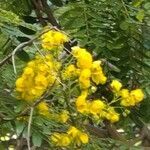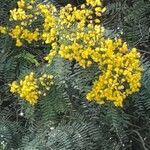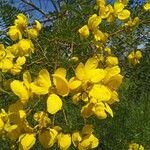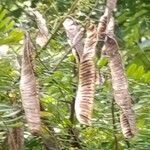Tree 10-15 m tall. Stems sparsely pubescent with appressed golden hairs, otherwise glabrous. Leaves 12-20 cm long, the petiole 0.5-1 cm long, the rachis bearing a conic, pointed nectary between the proximal and sometimes more distal pairs of leaflets; leaflets 15-30(-35) pairs per leaf, narrowly oblong, 1.5-4.5 cm long x 0.3-0.8 cm wide, apex rounded-mucronate, base asymmetrical, rounded, venation obscure except central midvein, darker above than below (at least when dried) Inflorescence a terminal exserted panicle 10-25 cm tall; sepals oblong-ovate, very unequal; petals unequal, the largest opposite the ovary and with raised, prominent abaxial venation; fertile stamens 7, the anthers of the 3 long abaxial stamens with an apical hooked beak to 1 mm long, the 4 median anthers with retuse beaks dehiscent by 2 terminal pores; ovary glabrous, displaced to one side of the flower curled, stigma porate. Fruits stipitate, flattened, broadly linear, 8-20 cm long x 1.3-2 cm wide; valves papery, black-brown, internally corky septate, seed compartments broader than long; seeds narrowly oblong, brown, bearing an elliptic areole on each face.
Shrubs, small trees, or trees, 7-20(-40) m tall. Young parts generally puberulent; branchlets reddish brown when dry. Leaves 12-20 cm; stipules early caducous, linear; rachis and petiole puberulent, with a long, ovoid gland on rachis between lowest pair of leaflets (often early caducous); leaflets 10-26(-50) pairs, linear-oblong or oblong, 1.2-4 × 0.6-0.8 cm, both surfaces puberulent or adaxially glabrous, apex obtusely rounded, mucronate, slightly oblique. Racemes several, arranged in a terminal, leafy panicle 10-20(-40) cm; peduncle and pedicels puberulent. Flowers 2.5-4 cm in diam.; bracts ovate, ca. 2 mm, tomentose. Sepals greenish yellow when mature, slightly unequal, 5-6 mm. Petals yellow, ovate-oblong, 1-2(-3) cm, glabrous. Fertile stamens 7, 3 larger, with filament ca. 10 mm and anthers 6-7 mm, staminodes 3, tiny. Ovary linear, glabrous. Legume dark brown, flat, broadly linear, obtuse. Seeds 30-60, flattened, ca. 6 mm.





